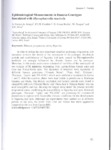Use este identificador para citar ou linkar para este item:
http://www.alice.cnptia.embrapa.br/alice/handle/doc/908666Registro completo de metadados
| Campo DC | Valor | Idioma |
|---|---|---|
| dc.contributor.author | ARAUJO, A. G. de | pt_BR |
| dc.contributor.author | CORDEIRO, Z. J. M. | pt_BR |
| dc.contributor.author | ROCHA, H. S. | pt_BR |
| dc.contributor.author | PASQUAL, M. | pt_BR |
| dc.date.accessioned | 2011-12-06T11:11:11Z | pt_BR |
| dc.date.accessioned | 2011-12-06T11:11:11Z | pt_BR |
| dc.date.available | 2011-12-06T11:11:11Z | pt_BR |
| dc.date.available | 2011-12-06T11:11:11Z | pt_BR |
| dc.date.created | 2011-12-06 | pt_BR |
| dc.date.issued | 2011 | pt_BR |
| dc.identifier.citation | In: PROMUSA SYMPOSIUM, 2011, Salvador. Bananas and plantains: toward sustainable global production and improved uses: abstracts. [Montepellier.]: [Bioversity International, 2011. p. 81. | pt_BR |
| dc.identifier.uri | http://www.alice.cnptia.embrapa.br/alice/handle/doc/908666 | pt_BR |
| dc.description | In order to define the most important variables in disease progression, it is necessary to know the details of the monocycle of the pathogen. Incubation periods and establishment of Sigatoka leaf spot, caused by Mycosphaerella musicola, are strongly influenced by climatic factors and by genotype. | pt_BR |
| dc.language.iso | eng | eng |
| dc.rights | openAccess | eng |
| dc.subject | Disease | pt_BR |
| dc.subject | Progression curve | pt_BR |
| dc.subject | Sigatoka | pt_BR |
| dc.title | Epidemiological measurements in banana genotypes inoculated with Mycosphaerella musicola. | pt_BR |
| dc.type | Resumo em anais e proceedings | pt_BR |
| dc.date.updated | 2013-11-01T11:11:11Z | pt_BR |
| riaa.ainfo.id | 908666 | pt_BR |
| riaa.ainfo.lastupdate | 2013-11-01 | pt_BR |
| dc.contributor.institution | A.GOMES DE ARAUJO, EMDAGRO; ZILTON JOSE MACIEL CORDEIRO, CNPMF; HERMINIO SOUZA ROCHA, CNPMF; M. PASQUAL, UFLA. | pt_BR |
| Aparece nas coleções: | Resumo em anais de congresso (CNPMF)  | |
Arquivos associados a este item:
| Arquivo | Descrição | Tamanho | Formato | |
|---|---|---|---|---|
| EpidemiologicalZILTONCORDEIRO.pdf | 248.3 kB | Adobe PDF |  Visualizar/Abrir |









